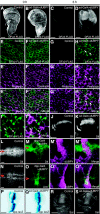Balanced ubiquitylation and deubiquitylation of Frizzled regulate cellular responsiveness to Wg/Wnt
- PMID: 20495530
- PMCID: PMC2905240
- DOI: 10.1038/emboj.2010.100
Balanced ubiquitylation and deubiquitylation of Frizzled regulate cellular responsiveness to Wg/Wnt
Abstract
Wingless (Wg)/Wnt has been proposed to exert various functions as a morphogen depending on the levels of its signalling. Therefore, not just the concentration of Wg/Wnt, but also the responsiveness of Wg/Wnt-target cells to the ligand, must have a crucial function in controlling cellular outputs. Here, we show that a balance of ubiquitylation and deubiquitylation of the Wg/Wnt receptor Frizzled determines the cellular responsiveness to Wg/Wnt both in mammalian cells and in Drosophila, and that the cell surface level of Frizzled is regulated by deubiquitylating enzyme UBPY/ubiquitin-specific protease 8 (USP8). Although ubiquitylated Frizzled underwent lysosomal trafficking and degradation, UBPY/USP8-dependent deubiquitylation led to recycling of Frizzled to the plasma membrane, thereby elevating its surface level. Importantly, a gain and loss of UBPY/USP8 function led to up- and down-regulation, respectively, of canonical Wg/Wnt signalling. These results unveil a novel mechanism that regulates the cellular responsiveness to Wg/Wnt by controlling the cell surface level of Frizzled.
Conflict of interest statement
The authors declare that they have no conflict of interest.
Figures







Comment in
-
Receptor endocytosis: Frizzled joins the ubiquitin club.EMBO J. 2010 Jul 7;29(13):2099-100. doi: 10.1038/emboj.2010.132. EMBO J. 2010. PMID: 20606702 Free PMC article. No abstract available.
References
-
- Cadigan KM, Fish MP, Rulifson EJ, Nusse R (1998) Wingless repression of Drosophila frizzled 2 expression shapes the Wingless morphogen gradient in the wing. Cell 93: 767–777 - PubMed
-
- Campuzano S, Modolell J (1992) Patterning of the Drosophila nervous system: the achaete-scute gene complex. Trends Genet 8: 202–208 - PubMed
-
- Chen W, ten Berge D, Brown J, Ahn S, Hu LA, Miller WE, Caron MG, Barak LS, Nusse R, Lefkowitz RJ (2003) Dishevelled 2 recruits β-arrestin 2 to mediate Wnt5A-stimulated endocytosis of Frizzled 4. Science 301: 1391–1394 - PubMed
Publication types
MeSH terms
Substances
LinkOut - more resources
Full Text Sources
Other Literature Sources
Molecular Biology Databases
Research Materials
Miscellaneous

